Garden Plants to Install in Coastal Areas
Many homeowners that own beachfront properties are faced with the challenge of finding what to use when having a landscape install, having a beachfront property is great but when it comes to choosing plants for your garden there are certain plants that can and will tolerate salt sprays.
Therefore it is important in knowing which plants will work for us and which plants will not. In this article, we will be looking at some plants, grasses, and shrubs that will serve us well giving us that closeness with nature.
Salt tolerant plants
I have worked with salt-tolerant plants for many years and have seen first hand how they can survive the harshest condition when it comes to salt sprays and still looks as beautiful and healthy as ever.
Here are a few salt-tolerant plants that you may consider when installing your garden.
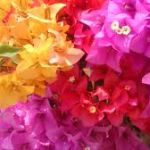
1. Bougainvillea makes a good salt-tolerant plant with its many colorful flowers, but be careful because in the midst of all that beauty these plants have thorns.
when planting in masses of different colors can give you that rainbow effect. Bougainvilleas are low maintenance and can survive on very little water. Pests such as the bougainvillea lopper can become a problem. Insecticides such as Sevin and soap sprays will help.
The disease of bougainvillea is called Bacterial leaf spot which is caused by a fungus. Bacterial leaf spot appears as a brown to reddish spot on the younger leaves, the leaves then appear rusty, and as the disease worsens the spots become dark. The edges of the leaves may also be deformed.
Treatment includes pruning diseased parts and applying a fungicide. Fertilize bougainvillea with bougain, 21-5-20, or ask your nurseryman for more suggestions with a choice of fertilizers. Remember the label is the law, so when applying chemicals or fertilizers read and follow as directed.
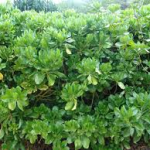
2. Scaevolas makes a great hedge, I have seen persons with beachfront properties plant these in masses. Scaevolas grow very dense therefore it is good to prune a few of the middle branches to allow the sun to be directed to the lower branches to ensure full growth.
Scaevolas are slow growers and require small amounts of water, keep an eye out for spider mites and aphids. Overwatering can cause the disease to set in, signs include leaf wilt. decrease watering and apply a fungicide. Fertilize Scaevola with a high nitrogen source. When applying chemicals and fertilizers read and follow the label because the label is the law.
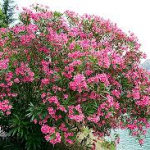
3. Oleanders are great flowering plants that have a nice showy bloom, the flowers of the oleanders are white, purple, light pink, yellow, white, or dark pink. When pruning be very careful because the sap can irritate your skin. The soil of these plants should be somewhat moist. The main pest problem includes aphids, caterpillars, and scales. Using liquid insecticides such as Telstar, upstar,t, etc.. will keep your plant in tip-top shape
Leaf spot disease in oleanders includes leaves that have brown or yellow spots when this happens, prune infected parts. When watering water at the base of the plant so that water does not get on plant leaves. Also applying a fungicide to your plant will help. A good fertilizer for oleanders is 10-10-10. Follow directions when it comes to using chemicals and fertilizers.
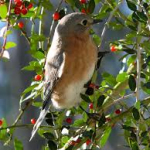
4. Yaupon holly will add that much- needed color to your landscape with its red berries, this plant makes a great garden feature. Keep holly well watered. Pest problems include mites, scales, leafminers, and spittlebugs. Applying insecticidal soap sprays will bring this problem under control.
Black Root Rot is caused by a fungus, this fungus lives in the soil and attacks the plant roots causing the plant not to perform as well, infected roots are black to dark brown, the plant also experience stunting of terminal growth and yellowing of leaves. Providing good drainage as well as applying a fungicide drench can help. Fertilize with 20-20-20. Read and follow directions when applying.
5. Star jasmine is a beautiful plant that shoots white flowers and has a wonderful aroma, adding this plant to your garden can really lighten up your garden area. Make sure to keep your jasmine plant well watered.
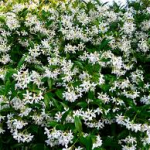
Scales and spider mites are the main pest problem, use insecticidal soap and your jasmine will be good as new. The disease of star jasmine includes wilt that destroys the roots. Signs include small roots becoming black but can be treated with a Bordeaux mixture.
Leaf blight is another disease that appears as brown-reddish spots on the leaves, leaves may also curl. The disease cause decrease in flower production. Applying Bordeaux to control the spread of disease. Fertilize jasmine with 10-10-10-10 0r 20-20-20.
Vines and ground covers
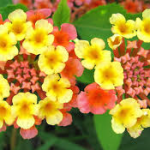
Vines and ground covers can also add that touch of flavor to your landscape and garden areas. Here are a few you can try
1. Lantanas makes a great ground cover, I have worked with lantanas and found them to do very well. These plants come in an array of colors and attract butterflies, they are low maintenance and can grow really well in little water. Pest problems include mealybugs, lace bugs, mites, aphids, whiteflies, and lantana leaf blotch miners.
Control these pests by using insecticidal soap sprays. The disease of lantanas includes botrytis blight and powdery mildew that is caused by a fungus. Powdery mildew appears as a white substance on the leaves of lantanas. The plant also loses leaves and leaves are deformed.
Prune infected parts and apply a fungicide. Lantanas are drought tolerant and over watering may cause root rot, allow the soil to dry out, and apply a fungicide drench will cause your lantana plant to bounce back. Fertilize lantanas with bloom booster or triple 10. read and follow the label when applying chemicals and fertilizers because the label is the law.
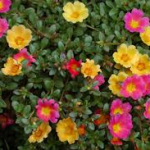
2. Portulacas are also great and can survive the salt sprays. This ground cover grows very dense and shoots small beautiful flowers. This is a low maintenance plant that can survive on small amounts of water. Portulacas are attacked by fungi that cause the plant to become diseased with root rot and white rust.
The use of a fungicide will bring these problems under control. Aphids are a known pest and applying insecticidal sprays will bring this insect under control. Fertilize with triple 1o.
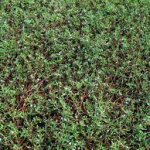
3. Sea Purslane is great and really do their job, this ground cover spreads really well and can completely cover your garden area, care should be taken when installing. Plant in masses around palm trees, the flowers are small and may not be that showy but it adds to the overall garden design. Sea purslane can survive on very little water. Sea purslane has no known pest problems.
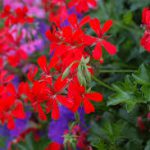
4. Geranium Ivy is are wonderful showy plants, I have worked with these plants over the years and in my opinion, they bring that soft touch. These plants are very delicate and should be handled with care. Geranium is often planted in hanging baskets and can be placed on porches or patios. Make sure that soil is moist, allow the plant to dry out a bit, and then water again.
The main pest problem includes aphids, spider mites, and whiteflies. Using a liquid soap spray will get the job done. The fungi of geranium ivy cause a disease known as gray mold, dying flowers, or drying leaves begin to rot once the rain and cold set in. Remove diseased parts and apply a fungicide, Fertilize with a light application of bloom booster. Follow the label when applying chemicals and fertilizers, because the label is the law.
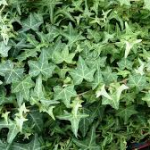
5. English Ivy makes a good ground cover, these plants are known as climbers and can do wonders for your garden area but be careful because this plant grows vigorously and can take over your garden. It is best to plant them by themselves or under tall trees.
Ivies can survive on small amounts of water. Pest problems include mealybugs, aphids, scales, and spider mites. The use of insecticidal soap will get rid of the pest.
Botrytis blight is caused by a fungus, signs include gray fuzzy mold that causes dead patches to appear on leaves and stems, the upper parts of stems, and eventually, the plant will die. Prune infected plant and thin for proper air circulation. Apply a fungicide, bacterial leaf spot signs include dark patches on wet leaves, the patches turn brown and forms a yellow cycle around spots, stems will dry up, and then death sets in.
Remove diseased parts and thin plant for proper air circulation and then apply a fungicide. Be careful not to overwater because root rot may occur, decrease watering and drench the soil with a fungicide. Fertilizer with triple 20, triple 10, etc.. follow the label and apply fertilizers and chemicals as directed.
Palms
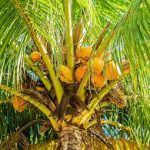
1. Coconut palms are great and can weather the salt sprays, there are many species of coconut palms. The benefit of installing these palms is the fruit that gives you a nice healthy taste of coconut water.
Coconut water has been used to help keep kidneys healthy and the insides of the coconut can be eaten also. Keep palms well watered.
Some palms can grow up to 80 feet. The disease includes leaf fall and bud rot younger leaves turn yellow and then brown, Crown of the plant may be waterlogged with a foul smell. Younger leaves can be pulled from the plant very easily.
Also, infected areas are pink to reddish, Remove infected plants. Fertilizers include nitrogen, potassium, magnesium, manganese, and boron. Read and follow as directed because the label is the law.
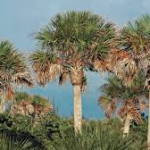
2. Cabbage palms are good salt-tolerant plants, care should be taken, however, and be careful not to damage the trunk, keep well watered. Palms can grow to 30 feet.
The main pest of cabbage palm is cabbage palm caterpillar which is a pinkish small bug, Control of this bug is difficult and you should contact a person trained in this area.
A serious disease of sable or cabbage palm is called Ganoderma root and Butt rot which is caused by a fungus. The first signs of infections are withering and dropping of older fronds, younger growth is pale green or yellow in color, and stunted. The trunk collapses and the head of the palm may fall off.
Palm may also have a hollow sound when knocked, flat mushroom looking material is seen at the base of the plant which is known as Conk. At this stage palms, life expectancy is short and Palm may die within the first three to five years.
Remove palm parts that are dead, always avoid injury to the trunk of the palm when mowing. So far to date, there is no chemical control for this disease. Fertilize with palm special and remember to follow directions because the label is the law.
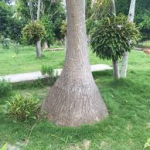
3. Bottle palm is a showy palm because the trunk is shaped just like a bottle. These palms grow to about 15 feet and should be given a good drink of water. Use palm special fertilizers and follow as directed.
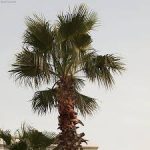
4. Washingtonia is a palm that grows up to 80 feet tall, these palms are very large and should be given a good amount of water. Fertilizer with palm special. Do not overwater because root rot will set in. Insects that attack this palm includes coconut mealybugs, scales, and leaf skeletonizer, Use soap sprays to bring insects under control and follow the label when applying fertilizers and insecticides.

5. Thatch Palms are an excellent choice, the leaves are used to create thatch roofs. Keep palms well water and they will serve you well. These palms grow up to 15 feet tall. There is no major pest or disease of this palm. Apply a palm special fertilizer. Be sure and follow the label when applying fertilizers, because the label is the law.
Salt tolerant Grass
Ornamental grass can further enhance your garden area, here are five ornamental kinds of grass you can use when gardening in an area that has high salt sprays
1. Mondo grass is a great salt-tolerant grass and has been known to survive salt sprays, this grass has a nice green color while shooting a small flower that may not be showy but this plant shows that it can take a punch and still look its best. Mondo grass can survive on very little water.
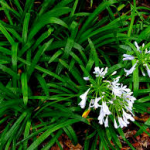
The pest problem includes scale insects which can be handled by using insecticidal soap sprays. Mondo grass can survive in full to partial sun. Overwatering can cause root rot, signs begin as leaf tip burn followed by yellowing and browning of leaves. Apply a soil drench and decrease watering will help. Fertilizer with 20-20-20. Read and follow the label before using chemicals and fertilizers because the label is the law.
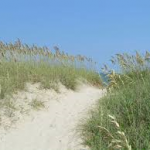
2. Sea oats can be found growing on coastlines and is a favorite when it comes to salt sprays. This grass grows somewhat tall and is a low maintenance plant that loves sandy soils and requires little water. Pest problems are low for this shore dweller. Do not overwater because this is a drought-tolerant plant, rust, and powdery mildew affects sea oats which are caused by a fungus. This disease first appears as a cobweb and as it spreads the plant takes on a white appearance as covered in flour. Rust disease cause the stems to take on a reddish appearance remove infected parts and thin plant allowing for proper air circulation. Fertilizer with 10-10-10. When using chemicals and fertilizers follow the label because the label is the law.
3. Muhly grass is a great salt-tolerant grass that can really handle the salt sprays. This grass is green in warm weather, but as the weather cools down it turns a beautiful purple to reddish color Muhly grass can survive on very little water.
Watch out for mealybugs that can be controlled with insecticidal soap. Overwatering can cause plant disease to develop. If disease sets in apply a fungicide, also look for the same signs like that of sea oat. Fertilize with a light application of 10-10-10, when applying chemicals and fertilizers read and follow the label because is the law.
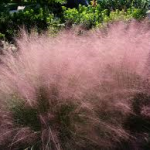
4. Muhly grass can take some salt but not too much and can survive on very little water. As the grass grows it can become bushy. I have seen pests such as mealybugs attack this grass, applying a soap solution or insecticidal soap will bring these bugs under control. Soil should be somewhat moist.
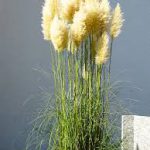
4. Pampas grass fear well and can take the salt sprays, grass can survive on very little water. Pampas grass shots a beautiful white-brownish flower, this is a hard plant and can spread once established. Look for the same signs as that of sea oat and followed as directed.
The final word
These are just a few of the many plants that can use to survive the salt sprays. So by taking advantage of these plants, will give you the garden you always wanted.
About the author
Norman loves being in the garden, both at home and for his job....
he is 'Natures Little helper' being outdoors, growing his vegetables and flowers from an early age.
Now having spent over 22 years in the profession he want to give some of his knowledge to others...
his vast array of hints and tips you will find scattered over this site will help you no end growing plants in your garden.

Great post! Recently, I have began gardening because I wanted to beautify the front of my house, however the plants that I planted and cultivated either died really fast or didn’t sprout at all. I hadn’t even thought about using salt tolerant plants, but your post caused me to see the brilliance in the idea. Thanks 🙂
Hello it is so nice to meet you. I am glad that I could help, all the best to you and have a good day.
Hi Norman.
This is a very interesting list of salt tolerant plants. I don’t own a beach front property, unfortunately. 🙂
I live in the USA. My home is in Central PA. I know that some of these plants wouldn’t work in the cold winters here. The reason I am interested in salt tolerant plants, is because of the salt that is put on the roads in the winter here. Some things won’t grow along or near my roads.
I liked the oleander. Is it something that could be grown in a cooler climate? I also liked the star jasmine.
I know you mentioned geraniums, and while we grow those here, they freeze in the winter.
Thank you for helping people know what plants they can plant on their beach front properties. Maybe someday I will own a beach front property. Who knows. 🙂
Jeannie
Hello It is so nice to meet you and I do hope that some day you get that beach front property. Oleanders as well as star jasmine prefer a more warmer climate. Serious cold can damage these plants and even kill them. What you may consider is to plant a few in pots and as the cold weather sets in bring them on the inside but in and area that gets some sunlight. Now if children or animals are around It would be good not to use this plant at all because the sap from this plant my cause illness if ingested the leaves have also been know to have and adverse effect if ingested also. So the best place for them is outdoors but stay tune because I will soon be publishing and article on plants that can survive the cold weather. All the best to you and have a good day.
Hello there!
You have an awesome site. You information is great for people that enjoy the garden and eating well. Whole foods are so expensive now a day and I love the landscaping tips you provide. i m purchasing a new home soon and I will use your information to make my garden grow.
Hello Mark it is so good to meet you, thanks for those kind words and best wishes to you on purchasing your new home. Also I wish you the best with your garden project, If I can be of further help to you please let me know, I will be more than happy to help. Have a good day.
Thank you for sharing. I didn’t realize that there were plants that were salt tolerant. I’m not much of a gardener but I have a small one in my back yard for vegetables and fruit as well as a small flower bed around my porch. Lately they have been dying out and I think this is the answer I needed. What do you suggest for plant food for plants, or is watering it enough?
Hello Guy it is so good to met you, plants are like humans and require the right kind of treatment or they will become sick. There may be several things that you may have to address like inspecting for insects, soil may need some organic material added to it, you r plant may be high maintenance and may need watering more often or they may be low maintenance and may be getting to much water, location also plays a big part. and the list goes on my best advice to you is to find out the names of your plants and send me and email so I can better understand what is going on. Plant names alone will help solve the problem because that will narrow the list and I will be able to help you more. Plant food can be 10-10-10, 20-20-20 or an organic source
But once I know the names of Your plants this will make finding out the problem more easy. Other that that you can search my website and look for the answer and if you don’t find It I will need a list of your plant names. All the best to you and have a good day.
Hi, Norman,
this is an interesting post, thank you very much. Do you know if there’re any plants or flowers in this list here that work better in hotter/ tropical climates? I imagine that there’ll be some that survive better in temperate climates which will be tough to keep alive in tropical weather.
Hello ash it is so good to meet, I am from the Bahamas where it is mostly warm year round. All of the plants in this list is grown here in the Bahamas and do very well. So if your are thinking of planting some of these they will all work because these are tropical warm season plants. Hope this helps, all the best to you and have a good day.
Hi! I just wanted to say you have some very useful advice on your page for new gardeners like myself.
I am also interested in building a garden pond and your tutorial makes it seem pretty easy to do! I will print out the information and get my supplies ready
Have a great day!
Hi! Jane it is good to meet you and I am glad that I could help. Wish you the best of success with your garden project. Have a nice day and please let me know how it goes.
Nrichards,
I like that website. It is perfect. I believe in, “whole foods” diets. I have experienced that diet. It is amazing as to how much your body rewards you when you honestly eat healthy. The food we take in does affect our health. I have experienced this myself. I have had health issues due to an unhealthy diet and I was truly amazed at what eating just green vegetables a few times a day did for me. I advocate a whole food diet to folks because I believe that true health care starts in the kitchen!
Thanks so much for an awesome website educating folks on nutrition!
JP
Hello JP and thanks a million for those kind words, your words alone shows me that my hard work is paying off, you made my day and I feel so encourage. Thanks a million and God’s willing I will do my best to continue to write helpful articles. All the best to you my friend and have a good day.
Hello Nrichards,
I love and enjoy gardening, it is one of the things that helps me to relax my mind. I have used some of the plants that you have shared that are salt tolerant but I never knew that they were salt tolerant.
I have really learnt a lot from your site. It is very informative and helpful for some of us.
Thank you for sharing this wonderful information.
Sunewako.
Hello sunewako it I so good to meet you and I am glad that I could help, all thebest to you and have a good day.
You could make any beachfront home look gorgeous with a combination of these plants. I particularly love the Bougainvillea and the potential rainbow effect you could get with a combination of colors. I don’t think I’d mind the thorns too much. Are you recommending plants tolerant to salt because of the spray from the ocean though? That was never really clear in the article.
-Jessica
Hello I am sorry and yes I am talking about sprays from the ocean that can do so much damage. All the best to you and have a good day.
I am getting ready to move to Florida and so I am glad I found this post. I am going from an area that is humid, but definitely not salty air. Oh, I love Bougainvillea. The first time I saw them was going to Cabo, and yes they were thriving everywhere. So colorful! Great idea too! I am very familiar with Oleanders. They are great flowering bushes. I find that they are a pretty hardy plant too. I have not heard of the Yaupon holly or Star Jasmine but I like them both as well. Going to book mark this for when I get to Florida!
Hello Matts Mom it is so good to see you, I was thinking how I have not heard from you in a long time, an I am glad that I could help.All tthe best to you and have a good day.
As someone who lives and exists besides the ocean it is very interesting for me to read about salt tolerant plants. I never knew such plants existed but it obviously makes so much sense. A very interesting article that has given me much food for thought in terms of the plants I opt for in the future. Cheers.
Hello lain it is so good to meet you, glad that I can help. All the best to you and have a good day.